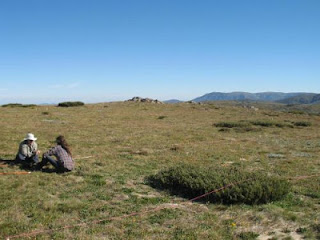This project now has >60 sites in grasslands across the globe (see http://nutnet.umn.edu/), with four in Australia: Kinypanial (a semi-arid grassland in southern Australia that I manage), Bogong (alpine grassland managed by Joslin Moore and myself), Mt Caroline in Western Australia (Suzanne Prober) and Burrawan in Queensland (managed by Jennifer Firn and Yvonne Buckley).
 |
| Bogong NutNet site |
 |
| Burrawan NutNet site |
 |
| Silwood Park NutNet site, England |
Our main questions are:
- 1) what are the relationships between diversity and productivity? This is an old question in ecology, with much hot air generated in the process about humped-back relationships, that we have addressed using our observational data. This resulted in the paper by Adler et al (2011) in Science.
- 2) are grasslands limited by multiple nutrients or one? This is being addressed by factorial field experiments where we add N, P and K singularly, and in combination. At Kinypanial, productivity is definately co-limited by N and P. Each nutrient, when added alone, has rather minimal impacts on productivity and diversity, but when added together, leads to a profound shift. Indeed, most of these plots (and the NPK plots) have been transformed from a native system to one dominated by the exotic annual grass Avena barbarta after 5 yrs of nutrient addition. Plots sown with N, P and K alone have a remarkable resilience to change. I was not expecting this.
- 3) is diversity controlled by nutrients (bottom-up processes) or herbivores (top-down processes)? In my sites, it definately seems that bottom-up processes rule, probably because native herbivores have been lost from many Australian grasslands (e.g. kangaroos, bandicoots, wombats) and hence, their current impacts on vegetation are minimal. This is not so true elsewhere in the world where large animals are still part of the natural system and they eat most of the biomass.
Eric Lind, the post-doc on the project, has just been interviewed on the Journal of Ecology Blog and explains the process of running a multi-site, global project with common aims. It's a good explanation of what we are doing and how NutNet can be (potentially) seen as a great model for successfully running such meta-analyse projects with standardised protocols. And the fishtank in the background is a nice touch!
You can see Eric at http://jecologyblog.wordpress.com/2012/10/12/interview-with-eric-lind-on-the-nutrient-network-nutnet/
In the current climate of declining research funding in Australia, multi-site network studies enable me to contribute to some of the big questions in ecology. The opportunity to ask 'big picture' questions, and collaborate with lots of smart people, has really opened my eyes as to the way I do science.
More soon.